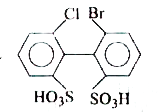Which of the following will show optical isomerism?




The correct Answer is:A, C, D
To determine which of the given compounds show optical isomerism, we will analyze each option step by step.
Step 1: Analyze the first compound (Spiro compound)
- Observation: The compound is a spiro compound.
- Criteria: For a spiro compound to show optical isomerism, it must have sp³ carbon atoms that are chiral (i.e., they must have different substituents).
- Conclusion: Since the sp³ carbon atoms in this compound have different valencies, this compound will show optical isomerism.
Step 2: Analyze the second compound
- Observation: This compound has a plane of symmetry (POS) and a center of symmetry (COS).
- Criteria: A compound with a plane of symmetry or a center of symmetry is achiral and cannot show optical isomerism.
- Conclusion: This compound will not show optical isomerism.
Step 3: Analyze the third compound (Ortho-substituted biphenyl)
- Observation: The compound is an ortho-substituted biphenyl.
- Criteria: For ortho-substituted biphenyls, if the two bulky groups are on adjacent carbons, the compound can be chiral and show optical isomerism.
- Conclusion: This compound will show optical isomerism.
Step 4: Analyze the fourth compound (Allene system)
- Observation: The compound is an allene.
- Criteria: An allene can show optical isomerism if it has sp² carbon atoms with different substituents.
- Conclusion: Since the sp² carbon atoms in this allene have different valencies, this compound will also show optical isomerism.
Final Conclusion
- The compounds that will show optical isomerism are:
- First compound (Spiro compound)
- Third compound (Ortho-substituted biphenyl)
- Fourth compound (Allene system)
Thus, the answer is that the first, third, and fourth compounds will show optical isomerism.
---
- Observation: The compound is a spiro compound.
- Criteria: For a spiro compound to show optical isomerism, it must have sp³ carbon atoms that are chiral (i.e., they must have different substituents).
- Conclusion: Since the sp³ carbon atoms in this compound have different valencies, this compound will show optical isomerism.
- Observation: This compound has a plane of symmetry (POS) and a center of symmetry (COS).
- Criteria: A compound with a plane of symmetry or a center of symmetry is achiral and cannot show optical isomerism.
- Conclusion: This compound will not show optical isomerism.
- Observation: The compound is an ortho-substituted biphenyl.
- Criteria: For ortho-substituted biphenyls, if the two bulky groups are on adjacent carbons, the compound can be chiral and show optical isomerism.
- Conclusion: This compound will show optical isomerism.
- Observation: The compound is an allene.
- Criteria: An allene can show optical isomerism if it has sp² carbon atoms with different substituents.
- Conclusion: Since the sp² carbon atoms in this allene have different valencies, this compound will also show optical isomerism.
- The compounds that will show optical isomerism are:
- First compound (Spiro compound)
- Third compound (Ortho-substituted biphenyl)
- Fourth compound (Allene system)
Similar Questions
Knowledge Check
Which of the following will not show optical isomerism ?
ACl−CH=C=CH−ClBBr−CH=C=CH−BrC D
D
Which of the following will not show optical isomerism as well as geometrical isomerism ?
A B
B C
C D
D
Which of the following will show optical activity?
A B
B C
C D
D
Which of the following can show optical isomersim?
View SolutionWhich of the following will show optical activity
View SolutionWhich of the following will show optical activity?
View SolutionWhich of the folllowing shows geometrical isomerism ?
View SolutionWhich of the following compound show optical isomerism?
View Solution